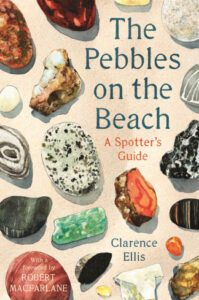When it comes to geology, I have long had what you might call “a bit of block.” For years I’ve tried to find the proper lever to shift that block out of my way in order to allow me to progress in my understanding – and enjoyment – of the subject, but nothing has quite been able to serve. Until very recently, that is, when my attention was piqued by news of the re-publication of a small book whose length of existence exceeds my own by just over a decade: Clarence Ellis’ The Pebbles on the Beach; A Spotter’s Guide.
Originally published in 1954, and – as is made clear in the new forward by Robert MacFarlane, when he opens by referring to it as “the stone-book of my childhood” – long known to those who appreciate the simple joy and beauty to be found in pebbles (as well as in searching for them), The Pebbles on the Beach seems to be one of the books you know about if your interested in the subject upon which it treats.
However to say that it is a book about geology would not be quite correct. While Mr. Ellis does delve into geology, he by no means limits himself to it. The same can be said of mineralogy, as it can about hydrology, oceanography, and half a dozen other fields of study. For while all of these – and a wide range of other topics as well – are incorporated into his absolutely charming, delightfully conversant prose, his topic, at its core, is the sheer enjoyment of a nice leisurely stroll more or less regularly punctuated by the discovery of an interesting pebble.
It’s really not very much more complex than that. Clarence Ellis enjoyed discovering pebbles; they appear to have been the doorway through which he found his enjoyment and understanding of this massive, ever-changing ball upon which we all live. Yet rather than scaling cliffs, diving into the ocean’s depths, or standing in contemplation of vast mountain vistas, he strolled along the shingle beaches for which Britain is well known and found satisfaction in the stones just beneath his feet. Would that we all could be so fortunate in our own quests.
Not a great deal appears to be known about Mr. Ellis. The book’s publisher sums up his life in a few short sentences. Born in Holyhead in 1889, he studied history at the University of Bangor, served in the First World War, and following that worked in “further education.” I’m not entirely sure just what “further education” means in the life of Mr. Ellis, but what he has written in this little book has most certainly furthered the education of countless readers.
In Mr. Ellis’ words, the core geological triad of igneous – sedimentary – metamorphic is not a lifeless description of the basic types of rocks found on the planet, rather it is a palette of base colors, red-yellow-blue if you will, from which he can go on to paint descriptions of more varied hues derived from these basic three. The reader, rather than struggle through the geologic vocabulary, is guided gently and amiably along through beautifully crafted, down-to-earth explanations of basalt, limestone, gneiss, and all the rest so that they become far more than just names. Indeed, he takes towering sea-side cliffs and places them literally in the palm of one’s hand.
Now, it is to be acknowledged that the prime pebble-finding grounds of which Mr. Ellis writes are in Great Britain, and a full seventy pages of the book is dedicated to a guided tour around that Scepter’d Isle’s coastline. However, this by no means makes it in any way less valuable a book to those in other parts of the world. Indeed, in my own home state of Oregon, there is but one shingle beach – a sea-tumbled basalt masterpiece named Black Pebble Beach (also called Cobble Beach) in the Yaquina Head Outstanding Natural Area – and I was moved to visit it at the first opportunity following my completion of the book. The experience was sublime, and although I have resided in the state all my life, I did not know of the existence of this remarkable place until Mr. Ellis’s book inspired me to go find it.
As The Pebbles on the Beach so astutely points out, a pebble is a mid-way point in a long and cyclical existence, it is perhaps most appropriate to conclude this review at the end of the book’s beginning. In the final paragraph of his introduction to the book, Mr. Ellis writes, “With understanding will come still greater enjoyment. To all who engage in this fascinating quest the author wishes good hunting, an insatiable curiosity and an ever-widening knowledge.” How could any naturalist ever even dare hope to be wished anything better than these three things?
 Title: The Pebbles on the Beach; A Spotter’s Guide
Title: The Pebbles on the Beach; A Spotter’s Guide
Author: Clarence Ellis, forward by Robert MacFarlane
Publisher: Faber & Faber
Format: Paperback
Pages: 240 pp. w / illustrations
Published: August 2018
ISBN: 9780571347933
Available from:
If you enjoyed reading this, please consider signing up for The Well-read Naturalist's newsletter. You'll receive a helpful list of recently published reviews, short essays, and notes about books in your e-mail inbox once each fortnight.

